|
|
|
|
 |
RODENTS: Muskrats |
|
|
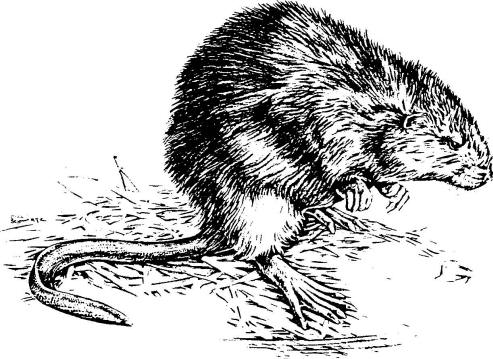
Fig. 1. Muskrat, Ondatra
zibethicus
Damage
Prevention and Control Methods Exclusion
-
Riprap the inside of a
pond dam face with rock, or slightly overbuild the
dam to certain specifications.
-
Cultural Methods and
Habitat Modification
-
Eliminate aquatic
vegetation as a food source.
-
Draw down farm ponds
during the winter months.
-
Frightening
-
Seldom effective in
controlling serious damage problems.
-
Repellents
-
None are registered.
-
Toxicants
-
Zinc phosphide.
-
Anticoagulants (state
registrations only).
-
Trapping
-
Body-gripping traps (Conibear®
No. 110 and others).
-
Leghold traps, No. 1,
1 1/2, or 2.
-
Where legal, homemade
“stove pipe” traps also are effective when properly
used.
-
Shooting
-
Effective in
eliminating some individuals.
-
Other Methods
-
Integrated pest
management.
Identification
The muskrat (Ondatra
zibethicus, Fig. 1) is the largest microtine rodent in
the United States. It spends its life in aquatic
habitats and is well adapted for swimming. Its large
hind feet are partially webbed, stiff hairs align the
toes (Fig. 2), and its laterally flattened tail is
almost as long as its body. The muskrat has a stocky
appearance, with small eyes and very short, rounded
ears. Its front feet, which are much smaller than its
hind feet, are adapted primarily for digging and
feeding.
The name muskrat, common
throughout the animal’s range, derives from the paired
perineal musk glands found beneath the skin at the
ventral base of the tail in both sexes. These musk
glands are used during the breeding season. Musk is
secreted on logs or other defecation areas, around
houses, bank dens, and trails on the bank to mark the
area.
The muskrat has an upper
and a lower pair of large, unrooted incisor teeth that
are continually sharpened against each other and are
well designed for gnawing and cutting vegetation. It has
a valvular mouth, which allows the lips to close behind
the incisors and enables the muskrat to gnaw while
submerged. With its tail used as a rudder and its
partially webbed hind feet propelling it in the water,
the muskrat can swim up to slightly faster than 3 miles
per hour (4.8 kph). When feeding, the muskrat often
swims backward to move to a more choice spot and can
stay underwater for as long as 20 minutes. Muskrat
activity is predominantly nocturnal and crespuscular,
but occasional activity may be observed during the day.
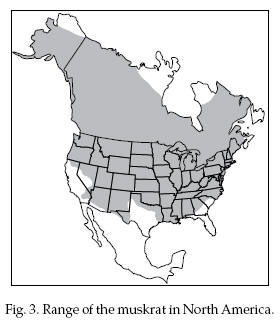 Range Range
The range of the muskrat
extends from near the Arctic Circle in the Yukon and the
Northwest Territories, down to the Gulf of Mexico, and
from the Aleutians east to Labrador and down the
Atlantic coast into Georgia (Fig. 3). The muskrat has
been introduced practically all over the world, and,
like most exotics, has sometimes caused severe damage as
well as ecological problems. Muskrats often cause
problems with ponds, levees, and crop culture, whether
introduced or native. Muskrats are found in most aquatic
habitats throughout the United States and Canada in
streams, ponds, wetlands, swamps, drainage ditches, and
lakes.
Habitat
Muskrats can live almost any place where
water and food are available year-round. This includes
streams, ponds, lakes, marshes, canals, roadside
ditches, swamps, beaver ponds, mine pits, and other
wetland areas. In shallow water areas with plentiful
vegetation, they use plant materials to construct
houses, generally conical in shape (Fig. 4). Elsewhere,
they prefer bank dens, and in many habitats, they
construct both bank dens and houses of vegetation. Both
the houses of vegetation and the bank burrows or dens
have several underwater entrances via “runs” or trails.
Muskrats often have feeding houses, platforms, and
chambers that are somewhat smaller than houses used for
dens.
Burrowing activity is the
source of the greatest damage caused by muskrats in much
of the United States. They damage pond dams, floating
styrofoam marinas, docks and boathouses, and lake
shorelines. In states where rice and aquaculture
operations are big business, muskrats can cause
extensive economic losses. They damage rice culture by
burrowing through or into levees as well as by eating
substantial amounts of rice and cutting it down for
building houses. In waterfowl marshes, population
irruptions can cause “eat-out” where aquatic vegetation
in large areas is virtually eliminated by muskrats. In
some locations, such as in the rice-growing areas of
Arkansas, muskrats move from overwintering habitat in
canals, drainage ditches, reservoirs, and streams to
make their summer homes nearby in flooded rice fields.
In aquaculture reservoirs, damage is primarily to levees
or pond banks, caused by burrowing.
Food Habits
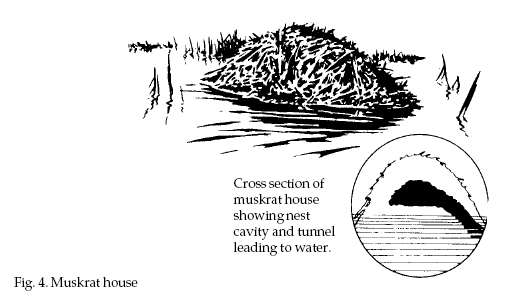
Muskrats are primarily herbivores. They will
eat almost any aquatic vegetation as well as some field
crops grown adjacent to suitable habitat. Some of the
preferred natural foods include cattail, pickerelweed,
bulrush, smartweed, duck potato, horsetail, water lily,
sedges, young willow regeneration, and other aquatics.
Crops that are occasionally damaged include corn,
soybeans, wheat, oats, grain sorghum, and sugarcane.
Rice grown as a flooded crop is a common muskrat food.
It is not uncommon, however, to see muskrats subsisting
primarily on upland vegetation such as bermuda grass,
clover, johnsongrass, and orchard grass where planted or
growing on or around farm pond dams.
Although primarily
herbivores, muskrats will also feed on crayfish,
mussels, turtles, frogs, and fish in ponds where
vegetation is scarce. In some aquaculture industry
areas, this feeding habit should be studied, as it may
differ significantly from normal feeding activity and
can cause economic loss.
General Biology, Reproduction, and Behavior
Muskrats generally have a small home range
but are rather territorial, and during breeding seasons
some dispersals are common. The apparent intent of those
leaving their range is to establish new breeding
territories. Dispersal of males, along with young that
are just reaching sexual maturity, seems to begin in the
spring. Dispersal is also associated with population
densities and population cycles. These population cycles
vary from 5 years in some parts of North America to 10
years in others. Population levels can be impacted by
food availability and accessibility.
Both male and female
muskrats become more aggressive during the breeding
season to defend their territories. Copulation usually
takes place while submerged. The young generally are
born between 25 and 30 days later in a house or bank
den, where they are cared for chiefly by the female. In
the southern states, some females may have as many as 6
litters per year. Litters may contain as many as 15, but
generally average between 4 and 8 young. It has been
reported that 2 to 3 litters per female per year is
average in the Great Plains. This capability affords the
potential for a prolific production of young. Young may
be produced any month of the year. In Arkansas, the peak
breeding periods are during November and March. Most of
the young, however, are produced from October until
April. Some are produced in the summer and early fall
months, but not as many as in winter months. The period
of highest productivity reported for the Great Plains is
late April through early May. In the northern parts of
its range, usually only 2 litters per year are produced
between March and September.
Young muskrats are
especially vulnerable to predation by owls, hawks,
raccoons, mink, foxes, coyotes, and — in the southern
states — even largemouth bass and snapping turtles. The
young are also occasionally killed by adult muskrats.
Adult muskrats may also be subject to predation, but
rarely in numbers that would significantly alter
populations. Predation cannot be depended upon to solve
damage problems caused by muskrats.
Damage and Damage Identification
Damage caused by muskrats
is primarily due to their burrowing activity. Burrowing
may not be readily evident until serious damage has
occurred. One way to observe early burrowing in farm
ponds or reservoirs is to walk along the edge of the dam
or shorelines when the water is clear and look for
“runs” or trails from just below the normal water
surface to as deep as 3 feet (91 cm). If no burrow
entrances are observed, look for droppings along the
bank or on logs or structures a muskrat can easily climb
upon. If the pond can be drawn down from 1 1/2 to 3 feet
(46 to 91 cm) each winter, muskrat burrows will be
exposed, just as they would during extended drought
periods. Any burrows found in the dam should be filled,
tamped in, and covered with rock to avoid possible
washout or, if livestock are using the pond, to prevent
injury to a foot or leg.
Where damage is occurring
to a crop, plant cutting is generally evident. In
aquaculture reservoirs generally maintained without lush
aquatic vegetation, muskrat runs and burrows or remains
of mussels, crayfish, or fish along with other muskrat
signs (tracks or droppings) are generally easy to
observe.
Legal Status
Muskrats nationwide for
many years were known as the most valuable furbearing
mammal — not in price per pelt, but in total numbers
taken. Each state fish and wildlife agency has rules and
regulations regarding the taking of muskrats. Where the
animal causes significant economic losses, some states
allow the landowner to trap and/or use toxic baits
throughout the year. Other states prohibit taking
muskrats by any means except during the trapping season.
Check existing state wildlife regulations annually
before attempting to remove muskrats.
Damage Prevention and Control Methods
Exclusion
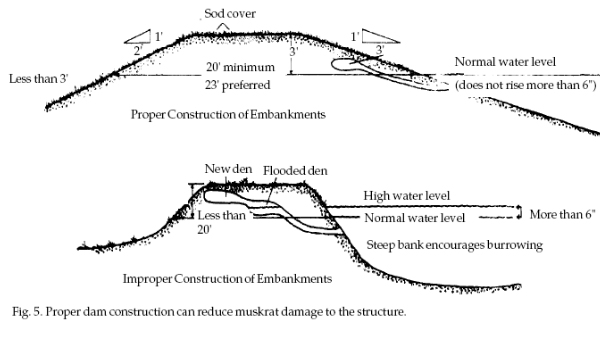
Muskrats in some
situations can be excluded or prevented from digging
into farm pond dams through stone rip-rapping of the
dam. Serious damage often can be prevented, if
anticipated, by constructing dams to the following
specifications: the inside face of the dam should be
built at a 3 to 1 slope; the outer face of the dam at a
2 to 1 slope with a top width of not less than 8 feet
(2.4 m), preferably 10 to 12 feet (3 to 3.6 m). The
normal water level in the pond should be at least 3 feet
(91 cm) below the top of the dam and the spillway should
be wide enough that heavy rainfalls will not increase
the level of the water for any length of time (Fig. 5).
These specifications are often referred to as
overbuilding, but they will generally prevent serious
damage from burrowing muskrats. Other methods of
exclusion can include the use of fencing in certain
situations where muskrats may be leaving a pond or lake
to cut valuable garden plants or crops.
Cultural Methods and
Habitat Modification
The best ways to modify habitat are to eliminate
aquatic or other suitable foods eaten by muskrats, and
where possible, to construct farm pond dams to
previously suggested specifications. If farm pond dams
or levees are being damaged, one of the ways that damage
can be reduced is to draw the pond down at least 2 feet
(61 cm) below normal levels during the winter. Then fill
dens, burrows, and runs and rip-rap the dam with stone.
Once the water is drawn down, trap or otherwise remove
all muskrats.
Frightening Devices
Gunfire will frighten muskrats, especially those
that get hit, but it is not effective in scaring the
animals away from occupied habitat. No conventional
frightening devices are effective.
Repellents
No repellents currently are registered for muskrats,
and none are known to be effective, practical, and
environmentally safe.
Toxicants
The only toxicant federally registered for muskrat
control is zinc phosphide at 63% concentrate. It is a
Restricted Use Pesticide for making baits. Zinc
phosphide baits for muskrats generally are made by
applying a vegetable oil sticker to cubes of apples,
sweet potatoes, or carrots; sprinkling on the toxicant;
and mixing thoroughly. The bait is then placed on
floating platforms (Fig. 6), in burrow entrances, or on
feeding houses. Use caution when mixing and applying
baits treated with zinc phosphide. Carefully follow
instructions on the zinc phosphide container before
using.
Some states have obtained
state registrations for use of anticoagulant baits such
as pivalyl, warfarin, diphacinone, and chlorophacinone.
These materials have proven effective, species
selective, practical, and environmentally safe in field
applications to control muskrats. Apparently there is
not sufficient demand or research available to consider
federal registration of anticoagulants for muskrats.
These same first-generation anticoagulants are, however,
federally registered for use in control of commensal
rodents in and around buildings, and for some use in
field situations for rodent control.
Use of the anticoagulant
baits, where registered, is in the form of a
paraffinized “lollipop” made of grain, pesticide, and
melted paraffin. It is placed in burrows or feeding
houses. The anticoagulant baits also can be used as a
grain mixture in floating bait boxes.
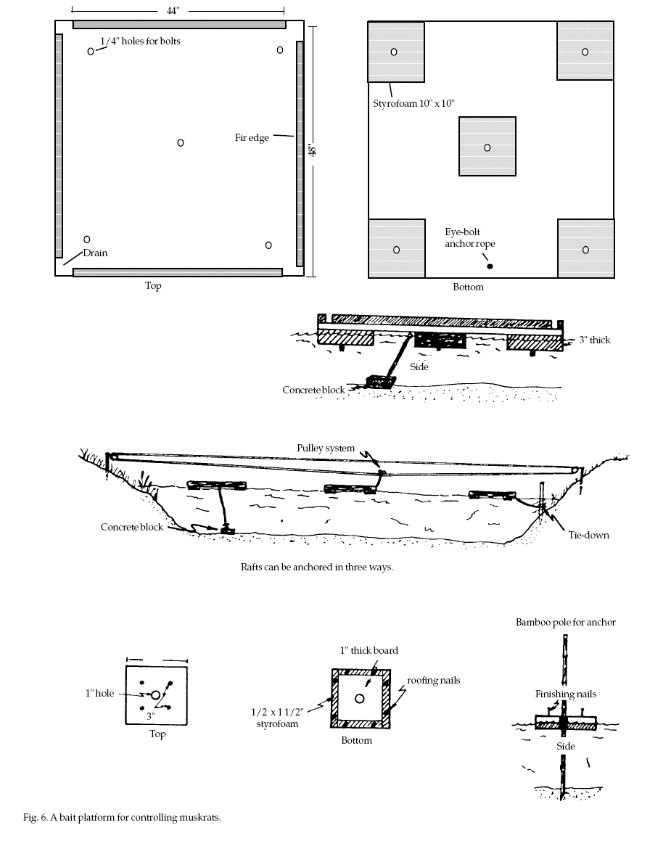
Fumigants
No fumigants are currently registered for muskrat
control.
Trapping
There have probably been more traps sold for
catching muskrats than for catching any other furbearing
species. A number of innovative traps have been
constructed for both live trapping and killing muskrats,
such as barrel, box, and stovepipe traps.
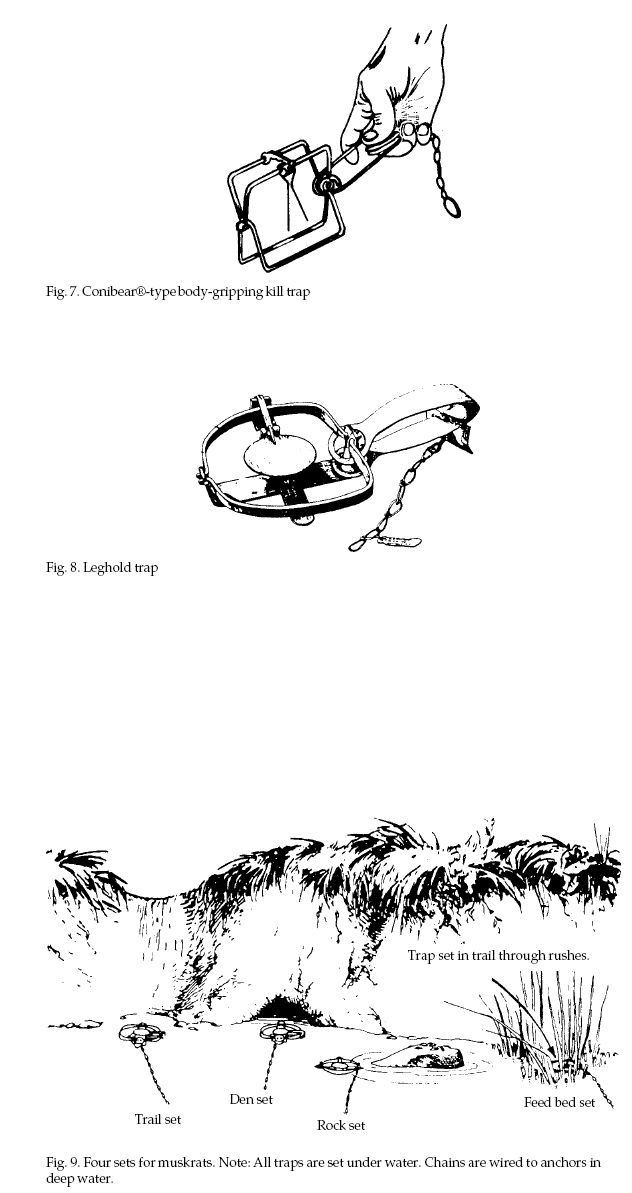
The most effective and
commonly used types of traps for muskrats, however, are
the Conibear®-type No. 110 (Fig. 7) and leghold types
such as the long spring No. 1, 1 1/2, or 2 (Fig. 8) and
comparable coil spring traps. Each type has places and
situations where one might be more effective than
another. The Conibear®-type, No. 110 is a preferred
choice because it is as effective in 6 inches (15 cm) of
water as at any deeper level. It kills the muskrat
almost instantly, thus preventing escapes. All that is
needed to make this set is a trap stake and trap.
Muskrats are probably the
easiest aquatic furbearer to trap. In most cases where
the run or burrow entrance is in 2 feet (61 cm) of water
or more, even a leghold trap requires only a forked
stake to make a drowning set. A trap set in the run, the
house or den entrance, or even under a feeding house,
will usually catch a muskrat in 1 or 2 nights. As a test
of trap efficiency, this author once set 36 Conibear®-type
No. 110 traps in a 100 acre (40-ha) rice field and 24
No. 1 1/2 leghold traps in a nearby 60-acre (24 ha)
minnow pond on a July day. The next day 55 muskrats were
removed. The remaining traps had not been tripped.
Obviously, both of these areas held high populations of
muskrats and Fig. 10. Pole set neither had been
subjected to recent control efforts. Results were 93.3%
effectiveness with the Conibear®-type, 87.5%
effectiveness with the leghold traps, and 100% catch per
traps tripped.
The most effective sets
are those placed in “runs” or trails where the muskrat’s
hind feet scour out a path into the bottom from repeated
trips into and out of the den. These runs or trails can
be seen in clear water, or can be felt underwater with
hands or feet. Which runs are being used and which are
alternate entrances can usually be discerned by the
compaction of the bottom of the run. Place the trap as
close to the den entrance as possible without
restricting trap movement (Fig. 9).
Other productive sets are
pole sets, under ice sets (Figs. 10 and 11), and culvert
sets. Other traps also can be used effectively in some
situations.
The stovepipe trap (Fig.
12) is very effective in farm ponds, rice fields, and
marshes — where it is legal. This type of trap requires
more time and effort to set, but can be very effective
if the correct size is used. The trap is cheap, simple,
and easy to make; however, to my knowledge, it is not
available commercially. If properly set in a well-used
den entrance, it will make multiple catches.
The stovepipe trap has the
potential to catch from two to four muskrats on the
first night if set in the primary den entrance. The trap
is cumbersome to carry around, however, and must be
staked down properly and set right up against the den
entrance to be most effective. The traps can be easily
made from stovepipe, as the name implies, but some of
the most effective versions are variations. An example
is a sheet metal, 6 x 6-inch (15 x 15-cm) rectangular
box, 30 to 36 inches (76 to 91 cm) long with heavy-gauge
hardware cloth or welded wire doors. The doors are
hinged at the top to allow easy entry from either end,
but no escape out of the box. Death from drowning occurs
in a short time. The trap design also allows for
multiple catches. Its flat bottom works well on most
pond bottoms and in flooded fields or marshes, and it is
easy to keep staked down in place. Such a trap can be
made in most farm shops in a few minutes. All sets
should be checked daily.
Trapping muskrats during
the winter furbearer season can be an enjoyable
past-time and even profitable where prices for pelts
range from $2.00 to $8.00 each. Price differences depend
on whether pelts are sold “in the round” or skinned and
stretched. Many people supplement their income by
trapping, and muskrats are one of the prime targets for
most beginners learning to trap. Therefore, unless
muskrats are causing serious damage, they should be
managed like other wildlife species to provide a
sustained annual yield. Unfortunately, when fur prices
for muskrats are down to less than $2.00 each, interest
in trapping for fur seems to decline. However, in damage
situations, it may be feasible to supplement fur prices
to keep populations in check.

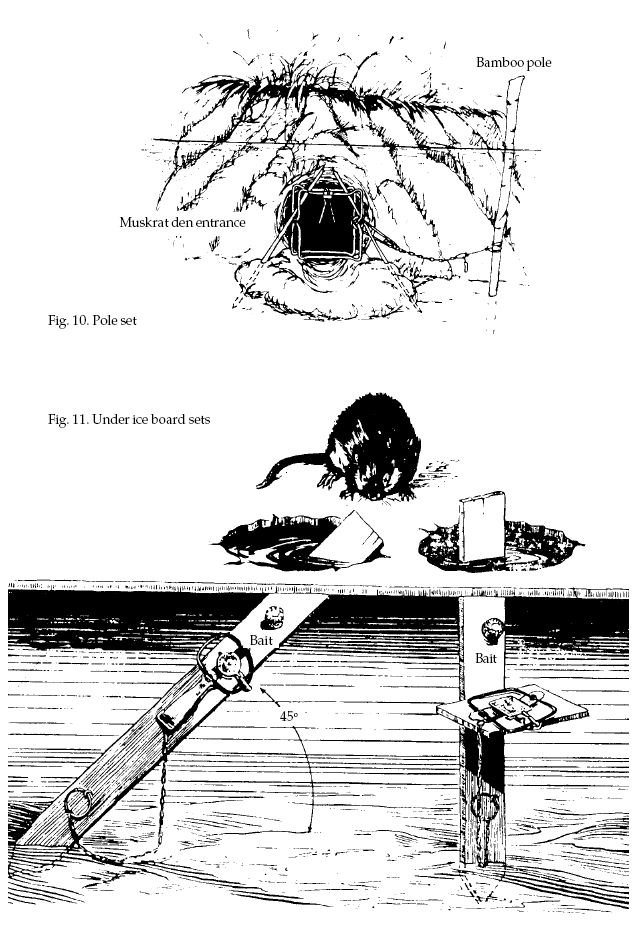
Shooting
Where it can be done safely, shooting may eliminate
one or two individuals in a small farm pond.
Concentrated efforts must be made at dusk and during the
first hours of light in the early morning. Muskrats shot
in the water rarely can be saved for the pelt and/or
meat.
Other Methods
Although a variety of other methods are often
employed in trying to control muskrat damage, a
combination of trapping and proper use of toxicants is
the most effective means in most situations. In
situations where more extensive damage is occurring, it
may be useful to employ an integrated pest management
approach: (1) modify the habitat by removing available
food (vegetation); (2) concentrate efforts to reduce the
breeding population during winter months while muskrats
are concentrated in overwintering habitat; and (3) use
both registered toxicants and trapping in combination
with the above methods.
Economics of Damage and Control
Assessment of the amount
of damage being caused and the cost of prevention and
control measures should be made before undertaking a
control program. Sometimes this can be easily done by
the landowner or manager through visual inspection and
knowledge of crop value or potential loss and
reconstruction or replacement costs. Other situations
are more difficult to assess. For example, what is the
economic value of frustration and loss of a truckload of
minnows and/or fish after a truck has fallen through the
levee into burrowed-out muskrat dens? Or how do you
evaluate the loss of a farm pond dam or levee and water
behind it from an aquaculture operation where hundreds
of thousands of pounds of fish are being grown? Rice
farmers in the mid-South or in California must often
pump extra, costly irrigation water and shovel levees
every day because of muskrat damage. The expense of
trapping or other control measures may prove
cost-effective if damage is anticipated.
Obviously, the assessments
are different in each case. The estimate of economic
loss and repair costs, for example, for rebuilding
levees, replacing drain pipes, and other measures, must
be compared to the estimated cost of prevention and/or
control efforts.
Economic loss to muskrat
damage can be very high in some areas, particularly in
rice and aquaculture producing areas. In some states
damage may be as much as $1 million per year. Totals in
four states (Arkansas, California, Louisiana, and
Mississippi) exceed losses throughout the rest of the
nation.
Elsewhere, economic losses
because of muskrat damage may be rather limited and
confined primarily to burrowing in farm pond dams. In
such limited cases, the value of the muskrat population
may outweigh the cost of the damage.
Muskrat meat has been
commonly used for human consumption and in some areas
called by names, such as “marsh rabbit.” A valuable
resource, it is delicious when properly taken care of in
the field and in the kitchen. Many wild game or outdoor
cookbooks have one or more recipes devoted to “marsh
rabbit.” Care should be taken in cleaning muskrats
because of diseases mentioned earlier.
Muskrat pelts processed
annually are valued in the millions of dollars, even
with low prices; thus the animal is certainly worthy of
management consideration. It obviously has other values
just by its place in the food chain.
Acknowledgments
For Additional Most of the information in
this chapter was obtained from experience gained in
Alabama, where as a youngster I trapped muskrats and
other furbearers to sell, and in Arkansas where muskrat
control is a serious economic problem. Colleagues in the
Arkansas Cooperative Extension Service, and especially
county extension agents, provided the opportunity and
background for obtaining this information. The Arkansas
Farm Bureau, many rice farmers, fish farmers, and other
private landowners/ managers, as well as the Arkansas
Game and Fish Commission and the Arkansas State Plant
Board, were also important to the development of this
information.
Figures 1 through 4 from
Schwartz and Schwartz (1981).
Figure 5 from Henderson
(1980).
Figure 6 from J. Evans
(1970), About Nutria and their Control, USDI, Bureau of
Sport Fisheries and Wildlife, Resour. Pub. No. 86. 65
pp.
Figures 7 and 8 from
Miller (1976).
Figures 9, 10, and 11 from
Manitoba Trapper Education publications.
Figure 12 by Jill Sack
Johnson.
Information Miller, J. E.
1972. Muskrat and beaver control. Proc. First Nat. Ext.
Wildl. Workshop, Estes Park, Colorado, pp. 35-37.
Miller, J. E. 1974.
Muskrat control and damage prevention. Proc. Vertebr.
Pest Conf. 6:85-90.
Miller, J. E. 1976.
Muskrat control. Arkansas Coop. Ext. Serv., Little Rock.
Leaflet No. 436.
Nowak, R. M. 1991.
Walker’s mammals of the world. 5th ed. The Johns Hopkins
Univ. Press. Baltimore, Maryland. 1629 pp.
Schwartz, C. W., and E. R.
Schwartz. 1981. The wild mammals of Missouri, rev. ed.
Univ. Missouri Press, Columbia. 356 pp.
Editors
Scott E. Hygnstrom; Robert M. Timm; Gary E.
Larson
PREVENTION AND CONTROL OF
WILDLIFE DAMAGE — 1994
Cooperative Extension
Division Institute of Agriculture and Natural Resources
University of Nebraska -Lincoln
United States Department
of Agriculture Animal and Plant Health Inspection
Service Animal Damage Control
Great Plains Agricultural
Council Wildlife Committee
05/17/2006
Special
thanks to:
Clemson University
|